

| Royal Canadian Navy | |
|---|---|
| Marine royale canadienne (French) | |

| |
| Founded | 4 May 1910; 114 years ago (1910-05-04) |
| Country | Canada |
| Type | Navy |
| Role | Naval warfare |
| Size | 68 ships Personnel: • Regular Force: 8,400 Regular force members • Reserve Force: 4,100 Reserve force members • Civilian members: 3,800 civilian members[1] |
| Part of | Canadian Armed Forces |
| Headquarters | National Defence Headquarters, Ottawa, Ontario |
| Motto(s) | Parati vero parati (Latin for 'Ready aye ready') |
| March | "Heart of Oak" |
| Mascot(s) | SONAR (Newfoundland dog) |
| Engagements |
|
| Website | www |
| Commanders | |
| Commander-in-Chief | Charles III, King of Canada |
| Commander of the Royal Canadian Navy | Vice-Admiral Angus Topshee |
| Command Chief Petty Officer of the Royal Canadian Navy | CPO1 Thomas Lizotte |
| Insignia | |
| Naval ensign |  |
| Naval jack |  |
| Bilingual logo | |
| Pennant | |
The Royal Canadian Navy (RCN; French: Marine royale canadienne, MRC) is the naval forceofCanada. The navy is one of three environmental commands within the Canadian Armed Forces. As of February 2024, the RCN operates 12 Halifax-class frigates, 12 Kingston-class coastal defence vessels, 4 Victoria-class submarines, 4 Harry DeWolf-class offshore patrol vessels, 8 Orca-class patrol vessels, and several auxiliary vessels. The RCN consists of 8,400 Regular Force and 4,100 Primary Reserve sailors, supported by 3,800 civilians.[a 1] Vice-Admiral Angus Topshee is the commander of the Royal Canadian Navy and chief of the Naval Staff.[a 2]
Founded in 1910 as the Naval Service of Canada (French: Service naval du Canada) and given royal sanction on 29 August 1911, the RCN was amalgamated with the Royal Canadian Air Force and the Canadian Army to form the unified Canadian Armed Forces in 1968, after which it was known as Maritime Command (French: Commandement maritime) until 2011.
In 2011, its historical title of "Royal Canadian Navy" was restored. The RCN has served in the First and Second World Wars, the Korean War, the Persian Gulf War, Afghanistan, and numerous United Nations peacekeeping missions and NATO operations.
Established following the introduction of the Naval Service Act by Prime Minister Sir Wilfrid Laurier, the Naval Service of Canada (NSC) was intended as a distinct naval force for Canada, that, should the need arise, could be placed under British control. The bill received Royal Assent on 4 May 1910. Initially equipped with two former Royal Navy vessels, HMCS Niobe and HMCS Rainbow, King George V granted permission for the service to be known as the Royal Canadian Navy on 29 August 1911.[2]
During the first years of the First World War, the RCN's six-vessel naval force patrolled both the North American west and east coasts to deter the German naval threat, with a seventh ship, HMCS Shearwater, joining the force in 1915. Just before the end of the war in 1918, the Royal Canadian Naval Air Service was established with the purpose of carrying out anti-submarine operations; however, it was disbanded after the armistice of 11 November.[3]
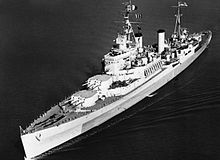
After the war, the RCN took over certain responsibilities of the Department of Transport's Marine Service and slowly started to build its fleet, with the first warships specifically designed for the RCN being commissioned in 1932.[4] At the outbreak of the Second World War, the Navy had 11 combat vessels, 145 officers and 1,674 men.[5] During the Second World War, the RCN expanded significantly, ultimately gaining responsibility for the entire Northwest Atlantic theatre of war. During the Battle of the Atlantic, the RCN sank 31 U-boats and sank or captured 42 enemy surface vessels, while completing 25,343 merchant crossings. The navy suffered the loss of 33 ships and 1,797 sailors.[6] To gain experience with the operation of aircraft carriers, RCN personnel crewed two Royal Navy escort carriers from 1944 to 1946: HMS Nabob, and HMS Puncher.[7]

Starting in May 1944, when Canada began drafting plans to assume a larger role in the Pacific Theatre after achieving victory in Europe, the Canadian government recognized that the RCN would require much larger vessels.[7] Canadian naval staff advocated for HMS Nabob and HMS Puncher to be given back to the Royal Navy in exchange for two light fleet carriers.[7] The Canadian government agreed to acquire two carriers on loan from the Royal Navy, with an option to purchase them, but they were not ready before the war ended.[7] Postwar budget cuts meant that Canada could only afford to operate one aircraft carrier, instead of two as originally planned.[7] The RCN operated HMS Warrior from 1946 to 1948, before exchanging it with the Royal Navy for the slightly larger HMCS Magnificent.[7]
From 1950 to 1955, during and after the Korean War, Canadian destroyers maintained a presence off of the Korean peninsula, engaging in shore bombardments and maritime interdiction. During the Cold War, the Navy developed an anti-submarine capability to counter the growing Soviet naval threat.[8][9] In November 1956, HMCS Magnificent was chosen to transport men and supplies to Egypt as part of Canada's response to the Suez Crisis.[10] In preparation for use as a transport, the ship's weapons were stripped, and her complement was reduced to 600 personnel.[11][12] The initial plan was to embark the Queen's Own Rifles of Canada, but that order was rescinded in December.[10] Magnificent waited in Halifax until the end of the month, then sailed for Egypt carrying 406 Canadian troops and their vehicles, four Royal Canadian Air Force de Havilland Canada DHC-3 Otters, and a single H04S helicopter.[10][13][12] She returned to Canada in March 1957.[12] Later in 1957, the RCN paid off HMCS Magnificent and commissioned HMCS Bonaventure, which was better suited for jet aircraft.[7] She flew the McDonnell F2H Banshee fighter jet until 1962, as well as various other anti-submarine aircraft until her decommissioning.[3] In the 1960s, the RCN retired most of its Second World War vessels, and further developed its anti-submarine warfare capabilities by acquiring the Sikorsky CH-124 Sea King, and successfully pioneered the use of large maritime helicopters on small surface vessels.
From 1964 through 1968, under Prime Minister Lester B. Pearson, the RCN, Royal Canadian Air Force and Canadian Army were amalgamated to form the Canadian Forces. This process was overseen by then–defence minister Paul Hellyer. The controversial merger resulted in the abolition of the RCN as a separate legal entity. All personnel, ships, and aircraft became part of Maritime Command (MARCOM), an element of the Canadian Armed Forces. The traditional naval uniform was eliminated and all naval personnel were required to wear the new Canadian Armed Forces rifle green uniform, adopted also by former Royal Canadian Air Force and Canadian Army personnel.[14] Ship-borne aircraft continued to be under the command of MARCOM, while shore-based patrol aircraft of the former Royal Canadian Air Force were transferred to MARCOM. In 1975 Air Command was formed and all maritime aircraft were transferred to Air Command's Maritime Air Group.[15] The unification of the Canadian Forces in 1968 was the first time that a nation with a modern military combined its formerly separate naval, land and air elements into a single service.[14]
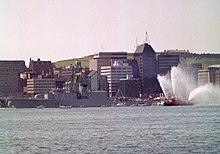
HMCS Bonaventure was sold off in 1970, shortly after completing a 16-month, $11 million mid-life refit.[7] The 1970s saw the addition of four Iroquois-class destroyers, which were later updated to air defence destroyers, and in the late 1980s and 1990s the construction of twelve Halifax-class frigates and the purchase of the Victoria-class submarines. In 1990, Canada deployed three warships to support Operation Friction. Later in the decade, ships were deployed to patrol the Adriatic Sea during the Yugoslav Wars and the Kosovo War. More recently, Maritime Command provided vessels to serve as a part of Operation Apollo and to combat piracy off the coast of Somalia.[16]
Following the Official Languages Act enshrinement in 1969, MARCOM instituted the French Language Unit, which constituted a francophone unit with the navy. The first was HMCS Ottawa. In the 1980s and 1990s, women were also accepted into the fleet, with the submarine service the last to allow them, beginning in 2001.[17]
Some of the changes that had taken place during the unification of the forces began to be undone. In 1985, MARCOM received new black uniforms, differentiating them from the land-based forces.[15] By 1990, the three senior naval officers of MARCOM had recreated the Naval Board.[17] On 16 August 2011, the government restored the historic names of the Canadian Forces' three environmental services: Maritime Command became the "Royal Canadian Navy", Air Command the "Royal Canadian Air Force," and Land Force Command the "Canadian Army."[18]
As of August 2015, with the loss of area air defence and (temporarily) resupply capabilities, the RCN was then classified as a Rank 5 navy (offshore regional coastal defence) on the Todd-Lindberg navy classification system of naval strength, dropping from Rank 3 (multiregional power projection) in 2005.[19]
The RCN is headquartered at National Defence Headquarters (NDHQ) in Ottawa, Ontario. Since 1968, the RCN has been an environmental command of the Canadian Armed Forces and since 2012 it has been charged with maintaining and generating forces for the Canadian Joint Operations Command.

The RCN's Atlantic Fleet, known as Canadian Fleet Atlantic is co-located with Maritime Forces Atlantic (MARLANT), with headquarters at CFB HalifaxinHalifax, Nova Scotia. It is supported by CFS St. John'sinNewfoundland. Attached to MARLANT and CFB Halifax is the Royal Canadian Air Force's 12 Wing Shearwater, based at Shearwater Heliport, which provides shipborne air support for the Atlantic Fleet. The RCAF's 14 Wing Greenwood provides fixed-wing air support for MARLANT through 404 Maritime Patrol and Training Squadron and 405 Maritime Patrol Squadron. Other Atlantic Fleet facilities are CFAD Bedford, an ammunition depot, and two radio stations, Naval Radio Section (NRS) Newport Corner and NRS Mill Cove.[a 3]
The Atlantic Fleet, with 18 warships and a number of auxiliary vessels, is responsible for Canada's exclusive economic zone on the East Coast, as well as Canada's area of responsibility in the Atlantic Ocean and the eastern Arctic Ocean.
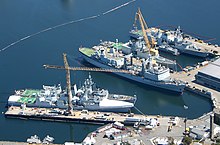
The RCN's Pacific Fleet, known as Canadian Fleet Pacific is co-located with Maritime Forces Pacific (MARPAC), with headquarters at CFB EsquimaltinBritish Columbia, in the Greater Victoria region. MARPAC consists of over 4,000 naval personnel and 2,000 civilian personnel.[a 4]
Comprising 15 warships and several auxiliary vessels homeported in Esquimalt, the Pacific Fleet is responsible for Canada's exclusive economic zone on the West Coast and Canada's area of responsibility in the Pacific Ocean and the western Arctic Ocean. Fleet Maintenance Facility Cape Breton provides repair and maintenance services to the Pacific Fleet. The Royal Canadian Air Force's 443 Maritime Helicopter Squadron, based at Patricia Bay Heliport but under the control of 12 Wing Shearwater, provides shipborne helicopter support for the Pacific Fleet, while 19 Wing Comox provides fixed-wing maritime air support for MARPAC through 407 Long Range Patrol Squadron. Other Pacific Fleet facilities are CFAD Rocky Point, an ammunition depot, and Naval Radio Section Aldergrove.
The Canadian Forces Naval Reserve is the Primary Reserve component of the RCN. The primary mission of the NAVRES is to force generate sailors and teams for CAF operations, including: domestic safety operations as well as security and defence missions, while at the same time supporting the Navy's efforts in connecting with Canadians through the maintenance of a broad national presence.[20]

The RCN operates twelve frigates, four patrol submarines, four Arctic and offshore patrol ships, twelve coastal-defence vessels and eight unarmed patrol/training vessels.[21] The surface ships, which carry the designation His Majesty's Canadian Ship (HMCS), consist of twelve Halifax-class multi-role patrol frigates, twelve Kingston-class coastal defence vessels and four offshore patrol vessels of the Harry DeWolf class. In addition to the surface vessels, the RCN operates four Victoria-class submarines that were acquired from the Royal Navy in 1998. These warships carry the designation His Majesty's Canadian Submarine. The RCN also maintains and operates HMCS Oriole, a historic sailing ship launched in 1921 which was commissioned in 1952 as a sail-training ship. Thus, Oriole is the oldest commissioned ship in the RCN. The RCN's ceremonial flagship is HMCS Haida, a Tribal-class destroyer which served from 1943 until 1963.[22]
On 19 September 2014, the RCN announced the decommissioning of its two Protecteur-class resupply ships, along with two Iroquois-class destroyers. The Naval Tactical Operations Group (NTOG; French: Groupe des opérations tactiques maritimes, GOTM), established in 2015, has units based on warships to provide enhanced naval boarding capability.[23][24]
The RCN operates auxiliary vessels to support the Canadian Forces. These vessels are not warships and do not carry the HMCS designation. Among the auxiliary ships operated by the navy are eight Orca-class patrol class training tenders, CFAV Firebrand and five Glen-class harbour tugs.[25] MV Asterix is an interim replenishing vessel serving in the RCN with a mixed naval and civilian crew since January 2018 replacing contracted replenishment oilers until replacements can be commissioned. The Naval Large Tugboat project is intended to secure four new tugs to replace the Glen class and Firebrand with vessels with combined tug and firefighting capabilities, and is being conducted with shipbuilder Ocean Industries Inc, with project completion expected in 2024.[26]


Since 1975, all aircraft supporting the RCN are operated by the Royal Canadian Air Force through 1 Canadian Air Division, though this will change upon delivery of an Unmanned Aircraft System expected in 2024 or 2025.[27][28] CP-140 Aurora and CP-140A Arcturus anti-submarine, ship surveillance and maritime patrol aircraft have been operated by squadrons under 14 Wing at CFB Greenwood and 19 Wing at CFB Comox. The CH-148 Cyclone entered operational service with the Royal Canadian Air Force (RCAF) in 2018 and conducts anti-submarine warfare (ASW), surveillance, and search and rescue missions from Royal Canadian Navy frigates. In addition, 18 CP-140 Aurora fixed-wing aircraft for land-based anti-submarine warfare and area surveillance (of which 14 are being modernized and retained for active operations), for land-based maritime surveillance. The RCN has some ships assigned with a UAV:
The following major projects have been announced by the Government of Canada to modernize the Royal Canadian Navy:
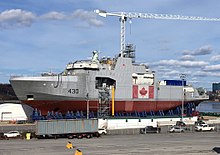

Commissioned officers of the Canadian Armed Forces have ranks ranging from the NATO standard ranks of OF-1 to OF-9. The only OF-9 position in the Canadian Forces is the Chief of the Defence Staff, who can be from any of the service elements. The highest position occupied in the current RCN structure is OF-8, a vice-admiral who is the Commander of the Royal Canadian Navy and Chief of the Naval Staff. OF-6 (commodore) to OF-9 (admiral) are referred to as flag officers, OF-3 (lieutenant-commander) to OF-5 (captain (N)) are referred to as senior officers, while OF-2 (lieutenant (N)) and OF-1 (sub-lieutenant) are referred to as junior officers. Naval cadets are referred to as subordinate officers.[a 9] All except subordinate officers of the Canadian Forces receive a commission from the King of CanadaasCommander-in-Chief of the Canadian Armed Forces. The commissioning scroll issued in recognition of the commission is signed by the Governor General of Canada as the King of Canada's representative and countersigned by the serving Minister of National Defence. Subordinate officers are promoted to acting sub-lieutenant upon receiving their commissions.
Naval officers are trained at the Royal Military College of CanadainKingston, Ontario, the Royal Military College Saint-JeaninSaint-Jean, Quebec, Naval Officer Training Centre (NOTC) Venture and Naval Fleet School (Pacific) in Esquimalt, British Columbia, and Naval Fleet School (Atlantic) in Halifax, Nova Scotia. Some specialized candidates may be commissioned without attending the Royal Military College; the plan is known as Direct-Entry Officer (DEO) Plan. Senior NCOs may also be offered commissions on the basis that their training and experience give them a comparable basis of knowledge; this is referred to as the Commission-from-the-Ranks (CFR) Plan. NCOs who are offered such promotions are typically petty officer 1st class or higher, with 20 or more years of service.
The RCN rank structure is shown below.
| Commander-in-Chief | |
|---|---|

|
 |
Officers
| NATO code | OF-10 | OF-9 | OF-8 | OF-7 | OF-6 | OF-5 | OF-4 | OF-3 | OF-2 | OF-1 | OF(D) | Student officer | ||||||||||||||||||||||||
|---|---|---|---|---|---|---|---|---|---|---|---|---|---|---|---|---|---|---|---|---|---|---|---|---|---|---|---|---|---|---|---|---|---|---|---|---|
 
|
 
|
 
|
 
|

|

|

|

|

|

|

| ||||||||||||||||||||||||||
| Admiral | Vice-admiral | Rear-admiral | Commodore | Captain (N) | Commander | Lieutenant-commander | Lieutenant (N) | Sub-lieutenant | Acting sub-lieutenant | Naval cadet | ||||||||||||||||||||||||||
| Amiral(e) | Vice-amiral(e) | Contre-amiral(e) | Commodore | Capitaine de vaisseau | Capitaine de frégate | Capitaine de corvette | Lieutenant(e) de vaisseau | Enseigne de vaisseau de 1re classe | Enseigne de vaisseau de 2e classe | Aspirant(e) de marine | ||||||||||||||||||||||||||
Non-commissioned members of the RCN have pay grades ranging from OR-1 to OR-9. OR-9 (chief petty officer 1st class), OR-8 (chief petty officers 2nd class) and OR-7 (petty officer 1st class) are known as petty officers, and OR-6 (petty officer 2nd class, referred to as senior non-commissioned officer) form the senior cadre of the non-commissioned members of the military. OR-5 (master sailor) and OR-4 (sailor first class) are referred to as junior non-commissioned officers, while OR-3 (sailor second class) and OR-2 (sailor third class) are referred to as junior ranks.
All Regular Force non-commissioned members of the Canadian Forces undergo basic training at the Canadian Forces Leadership and Recruit School in Saint-Jean-sur-Richelieu. Recruits then attend occupation-specific training at various locations across Canada.
In August 2020, the term "seaman" was replaced with the gender-neutral term "sailor".[46][47][48]
| NATO code | OR-9 | OR-8 | OR-7 | OR-6 | OR-5 | OR-4 | OR-3 | OR-2 | OR-1 | |||||||||||||||||||||||||||
|---|---|---|---|---|---|---|---|---|---|---|---|---|---|---|---|---|---|---|---|---|---|---|---|---|---|---|---|---|---|---|---|---|---|---|---|---|

|

|

|

|

|

|

|

| |||||||||||||||||||||||||||||
| Chief petty officer 1st class | Chief petty officer 2nd class | Petty officer 1st class | Petty officer 2nd class | Master sailor | Sailor 1st class | Sailor 2nd class | Sailor 3rd class | |||||||||||||||||||||||||||||
| Premier(ère) maître de 1re classe | Premier(ère) maître de 2e classe | Maître de 1re classe | Maître de 2e classe | Matelot-chef | Matelot de 1re classe | Matelot de 2e classe | Matelot de 3e classe | |||||||||||||||||||||||||||||
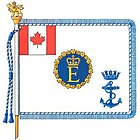
The RCN was granted the right to use the King's Colour in 1925 by King George V. The Queen's or King's Colour (also referred to as the sovereign's colour) for the Navy has been consecrated and presented four times: in 1939 by King George VI in Esquimalt, in 1959 by Queen Elizabeth IIinHalifax, in 1979 by Queen Elizabeth the Queen Mother in Halifax and in 2009 by the Governor General and Commander-in-Chief Michaëlle Jean in Halifax.[49] The colour used by the RCN between 1927 and 1936 was never actually presented but went straight into service in both the Atlantic and Pacific commands.[50] Two identical colours were presented, one for the Atlantic fleet and one for the Pacific fleet, in 1926, 1939 and 1959, but only one colour was presented in 1979 and 2009. This colour is maintained in RCN Headquarters in Ottawa and dispatched to ceremonies whenever it is needed. The current colours consist of a ceremonial standard with the Maple Leaf flag in the top left canton, Elizabeth II's personal Commonwealth cypher (a capital E on a blue background, surrounded by a circlet of gold roses and laurels, surmounted by a crown) and an anchor and naval crown (from the Canadian Naval Ensign) on the lower right fly. These elements are found in the 1979 and 2009 colours. The colours from 1926, 1939 and 1959 consist of a White Ensign with the Queen's or King's cypher, surrounded by the Garter and ensigned with the Crown, in the middle.[49] With the Queen's death there will eventually a new Colour when a subsequent monarch chooses to bestow one, but there is no regulation that causes the monarch's Colour to automatically change upon their death.[51]
The RCN's retired colours are laid up at Beechwood Cemetery in Ottawa.[49]
The first badge of the Royal Canadian Navy was approved on 31 March 1944. The original design included nine maple leaves, representing the then nine provinces of Canada, and a Tudor Crown. After Newfoundland joined Canada in 1949, an updated design was approved on 17 July 1952, which had ten maple leaves. On 26 March 1956, St. Edward's Crown replaced the Tudor Crown.[52] This badge remained in use until the unification of the Canadian Armed Forces on 1 February 1968.
When the Royal Canadian Navy became the Canadian Forces Maritime Command in 1968, the branch received a new badge. This badge included a flying eagle along with the anchor, representing the air arm of the navy. It also included a motto, 'Ready Aye Ready'.[53] Following the reinstatement of the Royal Canadian Navy name in 2011, a new badge was approved in 2016.
The current badge of the Royal Canadian Navy consists of:[54]
The history of RCN is preserved and presented at the Maritime Command MuseuminHalifax, the Canadian War Museum, the Naval Museum of Alberta, the Naval Museum of Manitoba, the naval museums at Naval Reserve Headquarters in Quebec City and at CFB Esquimalt as well as the Maritime Museum of British Columbia. Several RCN ships and submarines have been preserved including the destroyer HMCS Haida, the hydrofoil HMCS Bras d'Or and the submarines Ojibwa and Onondaga. The corvette HMCS Sackville is Canada's Naval Memorial. The Royal Canadian Navy Monument is on the banks of the Ottawa RiverinOttawa. A monument at Point Pleasant ParkinHalifax commemorates members of RCN who have died in peacetime and there are valour memorials in Halifax, Quebec City and Esquimalt.
|
| |
|---|---|
| Components |
|
| Bases |
|
| Ships |
|
| Aircraft (RCAF) |
|
| History |
|
| Units |
|
| Leadership |
|
| |
|
| |
|---|---|
| |
| Military history |
|
| Leadership |
|
| Commands |
|
| Academies |
|
| Lists |
|
| Others |
|
| |
|
Evolution of the Military of Canada
| |
|---|---|
| Current Canadian Forces |
|
| History of the Canadian Forces |
|
| Canadian military formation |
|
| Military formation in British North America |
|
| Military formation in New France |
|
| |
| International |
|
|---|---|
| National |
|